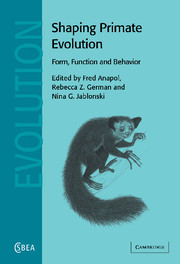Book contents
- Frontmatter
- Contents
- List of contributors
- Preface: shaping primate evolution
- 1 Charles Oxnard: an appreciation
- Part I Craniofacial form and variation
- Part II Organ structure, function, and behavior
- Part III In vivo organismal verification of functional models
- Part IV Theoretical models in evolutionary morphology
- Part V Primate diversity and evolution
- 16 The evolution of primate ecology: patterns of geography and phylogeny
- 17 Charles Oxnard and the aye-aye: morphometrics, cladistics, and two very special primates
- 18 From “mathematical dissection of anatomies” to morphometrics: a twenty-first-century appreciation of Charles Oxnard
- 19 Design, level, interface, and complexity: morphometric interpretation revisited
- 20 Postscript and acknowledgments
- Index
- References
17 - Charles Oxnard and the aye-aye: morphometrics, cladistics, and two very special primates
Published online by Cambridge University Press: 10 August 2009
- Frontmatter
- Contents
- List of contributors
- Preface: shaping primate evolution
- 1 Charles Oxnard: an appreciation
- Part I Craniofacial form and variation
- Part II Organ structure, function, and behavior
- Part III In vivo organismal verification of functional models
- Part IV Theoretical models in evolutionary morphology
- Part V Primate diversity and evolution
- 16 The evolution of primate ecology: patterns of geography and phylogeny
- 17 Charles Oxnard and the aye-aye: morphometrics, cladistics, and two very special primates
- 18 From “mathematical dissection of anatomies” to morphometrics: a twenty-first-century appreciation of Charles Oxnard
- 19 Design, level, interface, and complexity: morphometric interpretation revisited
- 20 Postscript and acknowledgments
- Index
- References
Summary
The aye-aye and the question of strepsirhine monophyly
The two suborders of primates, Haplorhini and Strepsirhini, are distinguished clearly by four well-studied and anatomically complex characters:
The possession by Strepsirhini of a rhinarium. A rhinarium is widespread among mammals generally, and its possession by Strepsirhini among primates is undoubtedly plesiomorphic.
The presence in Strepsirhini of a tapetum lucidum in the eye. Although a tapetum is likewise widespread among mammals, its structure differs from one group to another, so its polarity among primates is unclear.
The existence of a fovea in the retina in the Haplorhini. A retinal fovea appears to be unique to Haplorhini, except that an approach to it is seen in Lemur catta and Hapalemur griseus (Pariente, 1970). The most parsimonious interpretation is that it is a haplorhine apomorphy, and that there has been some convergent development of one in the two lemurid taxa cited.
A complex of characters of the fetal membranes, such that the placenta is hemochorial in Haplorhini but epitheliochorial in Strepsirhini. Martin (1990), noting that some trophoblastic invasion occurs in two species of galago, argued that the primitive state is endotheliochorial, and that consequently both epitheliochorial and hemochorial states are derived; but the cladistic analysis of Luckett (1993) concluded that the condition in the Strepsirhini is primitive.
It would appear, therefore, that of these four characters the Strepsirhini are questionably derived in only one, the presence of a tapetum. Otherwise, they are defined only by plesiomorphic retentions. What, then, is the evidence that the Strepsirhini really are monophyletic?
- Type
- Chapter
- Information
- Shaping Primate EvolutionForm, Function, and Behavior, pp. 368 - 377Publisher: Cambridge University PressPrint publication year: 2004
References
- 5
- Cited by



